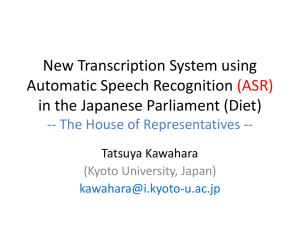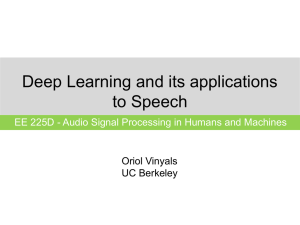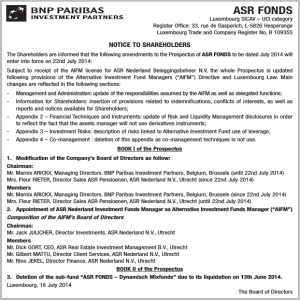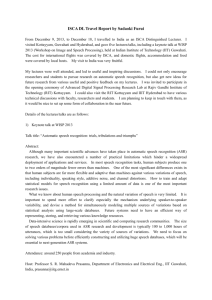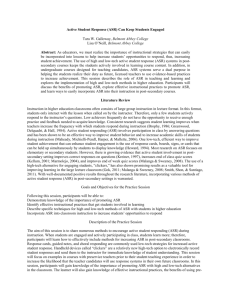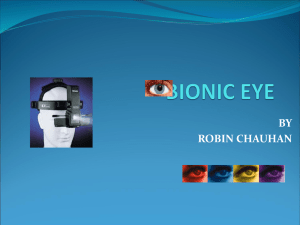ArtifSysRes CSER`11 Troncale
advertisement
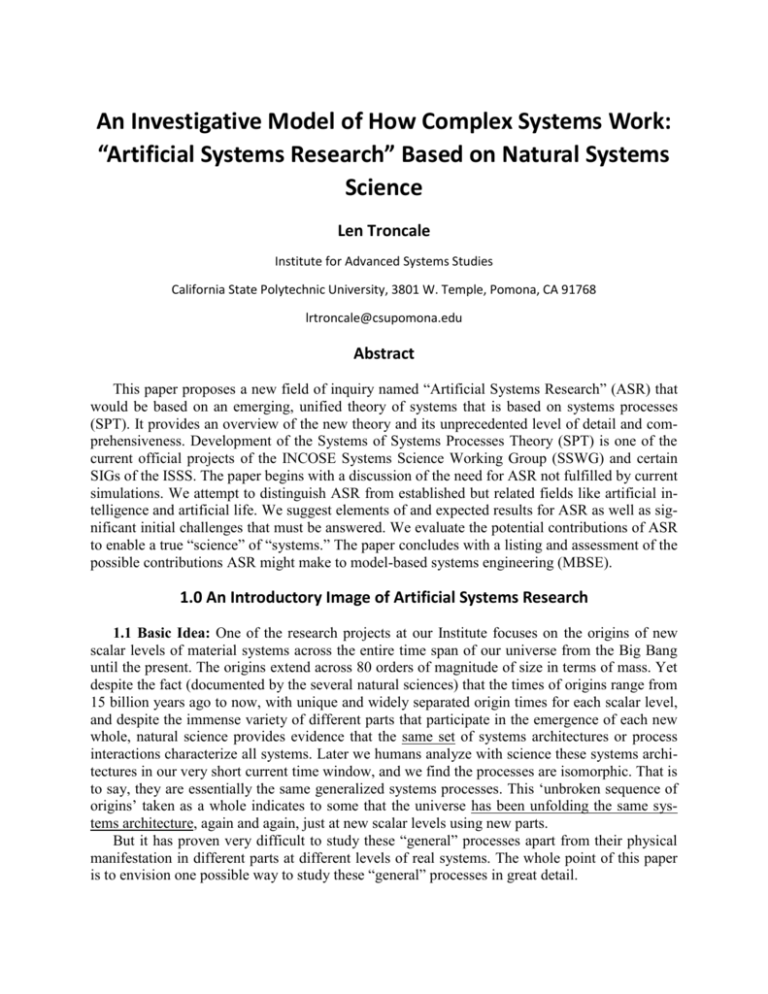
An Investigative Model of How Complex Systems Work: “Artificial Systems Research” Based on Natural Systems Science Len Troncale Institute for Advanced Systems Studies California State Polytechnic University, 3801 W. Temple, Pomona, CA 91768 lrtroncale@csupomona.edu Abstract This paper proposes a new field of inquiry named “Artificial Systems Research” (ASR) that would be based on an emerging, unified theory of systems that is based on systems processes (SPT). It provides an overview of the new theory and its unprecedented level of detail and comprehensiveness. Development of the Systems of Systems Processes Theory (SPT) is one of the current official projects of the INCOSE Systems Science Working Group (SSWG) and certain SIGs of the ISSS. The paper begins with a discussion of the need for ASR not fulfilled by current simulations. We attempt to distinguish ASR from established but related fields like artificial intelligence and artificial life. We suggest elements of and expected results for ASR as well as significant initial challenges that must be answered. We evaluate the potential contributions of ASR to enable a true “science” of “systems.” The paper concludes with a listing and assessment of the possible contributions ASR might make to model-based systems engineering (MBSE). 1.0 An Introductory Image of Artificial Systems Research 1.1 Basic Idea: One of the research projects at our Institute focuses on the origins of new scalar levels of material systems across the entire time span of our universe from the Big Bang until the present. The origins extend across 80 orders of magnitude of size in terms of mass. Yet despite the fact (documented by the several natural sciences) that the times of origins range from 15 billion years ago to now, with unique and widely separated origin times for each scalar level, and despite the immense variety of different parts that participate in the emergence of each new whole, natural science provides evidence that the same set of systems architectures or process interactions characterize all systems. Later we humans analyze with science these systems architectures in our very short current time window, and we find the processes are isomorphic. That is to say, they are essentially the same generalized systems processes. This ‘unbroken sequence of origins’ taken as a whole indicates to some that the universe has been unfolding the same systems architecture, again and again, just at new scalar levels using new parts. But it has proven very difficult to study these “general” processes apart from their physical manifestation in different parts at different levels of real systems. The whole point of this paper is to envision one possible way to study these “general” processes in great detail. The use of the term “artificial” here refers to the attempt to place these isomorphic attributes of systems-in-general, or pure systems architectures in cyberspace instead of having them expressed in a material time-space configurations as they have across the history of the universe. Imagine a program that not only simulates the actions and dynamics of nearly 100 systems processes, but also their mutual and global influences on each other running in computer space. This would be an image of ASR. 1.2. ASR Value-Added: There are immense numbers of models and simulations of real systems. There are many tools to assist and assess these models and simulations. Why attempt to construct an artificial network of abstract dynamics in what might seem to be the ultimate artificial context, virtual existence……in silico? We propose and describe four classes of value-added that characterize this effort in “Need for an ASR” (Section 3). Here are some additional introductory reasons. (5) Whereas other models and simulations are dominated by the parts and part interactions they include, ASR is dominated by complete focus on the systems architectures several abstraction levels distant from the parts. (6) It is expected that the attempt to construct an ASR will generate, stimulate, enable, or even “force” new questions that are significantly more fundamental in nature because of the fundamental nature of the systems processes and their mutual interactions that they model. Notice that each of the four verbs used captures a different and unique strategy for evincing the questions. (7) The primary reason would be the hope that it would allow actual “direct testing” of an immense number of alternative systems architecture configurations and measures of the consequences of each configuration. Current simulations may enable this for very constrained 2.0 An ASR Based on a Unified Systems Processes Theory (SPT) It is ironic that there exists such a large number of fragmentary, domain-dependent, discipline-dependent or tool-dependent systems theories. Indeed, one is moved to ask if we can call them internally consistent and complete theories at all. The INCOSE SSWG is studying how to integrate more than 75 such independent theories or approaches! We usually describe this as a D/D/T situation. Many candidate theories are domain-dependent, discipline-dependent, or tool dependent. DDT is a poison. We suggest D/D/T is also a “poison” to systems thinking. It is a powerful aid to reductionist experimental approaches. However, it has the opposite effect on the transdisciplinary thinking necessary for systems approaches. 2.1 What is Natural Systems Science? As an initial working position, we consider the conventional fields of science as natural. Astronomy, physics, chemistry, geology, and biology study phenomena that long preceded human existence. They would continue to function without humans at all. The exciting new fields of Systems Biology (e.g. Cassman 2007), Systems Chemistry, and Earth Systems Science are attempting to study their respective phenomena on a “systems” level that involves vastly more data, on vastly more parts, with vastly more interactions included. But both the data from the conventional approaches as well as the new data from the systems approaches can be combined to yield a natural systems science that is nevertheless based on reductionist experiments providing the best of both worlds. The downside of portraying these disciplines as “natural” is the resulting tendency to then portray all human artefacts as “artificial.” An extended debate on these working distinctions is underway by the INCOSE SSWG (see https://sites.google.com/site/syssciwg). 2.2 How is the SPT based on Natural Systems? The SPT, upon which ASR would be based, uses a wide range of case studies and empirical results from natural systems science. Our Institute combines this data with the ideas accumulated from nearly a hundred years and five distinct generations of systems approaches to formulate the catalogue of SP’s and their interactions that are the SPT. 2.3 Why focus on Systems Processes (SP’s)? The SPT seeks to accomplish integration of other theories by incorporating only what they reveal about systems processes, the transformations that determine how systems work. These are more neutral than other parts of theories and simultaneously more fundamental. By allowing only SP input, SPT avoids D/D/T effects. 2.4 Systems Processes Theory (SPT): Description of this theory is not within the space limitations of this paper (see Troncale 1978, 1982). SPT currently uses a listing of ~100 systems processes and the 15 categories of data we collect on each systems process from the literature. By incorporating only the systems processes, SPT is essentially a theory on how systems work. Since only SP’s that have been shown to be isomorphic across many real systems, even across many disciplines, domains, tools, and scales of being, they present a putative model of how systems work in general. 2.5 Linkage Propositions (LP’s): The main contribution of the SPT is less in its SP’s than its formulation of linkage propositions (LP’s). These are formal language-based statements of observed influences of one systems process on another. There inclusion makes the SPT a “system” of systems processes. Influences can be traced in “chains,” in “cycles,” in “nets,” and other systems architectures that are themselves potentially as isomorphic as the SP’s alone. This yields a more in depth model than many provided in past systems theories. 3.0 Need for ASR? Why propose another “artificial” discipline when we already have a developed Model Based Systems Engineering history and several well-established disciplines or strains of in silico simulations with literatures, findings, conference series, and journals? 3.1 For Systems Science - Foundation of SE: Clearly something is missing in the diverse community that calls itself dedicated to systems approaches or systems thinking if we feel it necessary to integrate some 75 competing approaches. The efforts range from pure philosophy to many restricted to only local clusters of real systems all the way to social management and values. If ASR can provide a testable systems theory, then it would have the potential for helping achieve a consensus. Even if it was not used for that enviable purpose, its practice should add significant new knowledge to our understanding of systems. 3.2 Needs in Systems Engineering: Some would argue that the praxis as well as the theory underlying SE should be systems science. That may be the reason that the “Systems Science” and also “Complex Systems” Working Groups self-organized in INCOSE and have attracted over 100 members each. But various subgroups within INCOSE are loyal to or only cognizant of one or another of the many competing systems theories. So there is a need in SE for more education and information exchange on the topic of systems. There may even be a need to add systems science to the core of courses used to prepare systems engineers. 3.3 Needs in the Natural Sciences: One of the most unexpected results of SPT and perhaps an ASR is that these pursuits may suggest many new hypotheses for the conventional sciences and even help for the “systems” version of each. It is not the subject of this paper, but the isomorphic aspect of the SPT suggests that systems mechanisms found in one science may be usefully applied, even if never conceived before, in other disciplines. The detail in SPT could become a major initiator of hypotheses for experiments that otherwise might never be attempted. 3.4 Needs for Human Systems Applications - Sustainability: We face numerous systems of systems problems. Many are very complex hybrids of both natural and human systems. A theory of how systems work that is equally isomorphic to both could help integrate understanding and solutions across the two urdomains. It might also bring some needed rigor to new fields of high moral motivation but weak in terms of their knowledge base like “sustainability” or “regenerative studies.” 4.0 How Would ASR be Different From ……… The above citation of several fields that already bear the adjective “artificial” in their titles raises the valid issue of whether or not this is actually a new field or just a subset of the established fields. 4.1 Artificial Life (AL): It has been a mere 25 years since Langton coined the term “artificial life” (Langton 1987, 1995) yet the area is widely known and has generated significant literatures, conference series, research grants, and academic units Perhaps this is due to the “romance” inherent in living systems simply because humans are life systems. Perhaps it is the exotic threat implicit in suggesting life that is “artificial.” But AL practitioners might argue the success of the new field is due to it’s the increased understanding AL brings to biology. As a practicing cell and molecular biologist, I am skeptical of the depth of contribution of this approach, although respectful of the enthusiasm and energy of the effort. Conventional biologists would much rather investigate real systems. In fact, many of the algorithms used in artificial life (info sequences, replication, mutation, translocation, addition, deletion, inversion, etc.) as well as the prominent results (selection, adaptation, speciation, evolution) were borrowed from the extensive original studies in conventional biology. Still it is useful to contrast the proposed “artificial systems research” (ASR) from AL. Here are some contrasts. (i) ASR would clearly be different from the “hard” and “wet” types of AL, yet it would also have significant differences from the “soft” category it is closest to. (ii) ASR could not use the same “reproduction” or “selection” algorithms used by AL. It would have to innovate entirely different algorithms to accomplish what these do in AL. (iii) AL imitates biological systems, while ASR must include modelling a far wider range of real systems than only the biological. (iv) ASR would utilize algorithms not found in all of AL especially in its simulation of processes dominant in physical systems. (v) ASR would not use the list of genetic algorithms that introduce variation in AL (mutation to inversion, etc. above) 4.2 Artificial Chemistry (AC): The same necessity as above obtains for distinguishing ASR from other “artificial” fields such as AC. Some of the distinctions might be: (i) ASR would be modelling a far wider range of entity systems than chemical entities, mostly limited to molecular and atomic scales. (ii) AC models chemical reactions which are clearly a subset of the transformations modelled in ASR. (iii) AC relies more on “closed” sets or “organizations” while ASR is virtually exclusively modelling open systems, there being no truly closed system in nature. 4.3 Artificial Intelligence: Finally the grandfather of all the “artificial” approaches has to be AI. How might ASR be different from AI? (i) AI essentially focuses on “logic” and “intelligence” whereas ASR focuses on physical transformations. (ii) AI has focused on machines in the past whereas ASR focuses on products of nature, not programmed products of man (machines). (iii) AI has fragmented into as many subfields as systems science while ASR has integration as its prime purpose. But since we suggest use of both LISP and PROLOG below, both pillars of AI, there may be significant overlap between the AI and ASR. Both AI & ASR rest upon very extreme levels of abstraction. 4.4 Isn’t any model or simulation an ASR? Those in INCOSE who have dedicated their careers to Model Based Systems Engineering would certainly challenge ASR by stating that any model or simulation they build has some utility in further elucidating how systems work. ASR would not contest that statement. But it is also true that, if successfully implemented as formulated below, ASR would accomplish more direct inquiry into how systems work in general than any particular model or simulation of one particular system. 5.0 Elements of /or/ Steps To an ASR Program How do you digitize a generic, already abstract set of processes and linkages? That is the central question raised in this paper. As an introductory paper, we can only here frame avenues to pursue in answering this challenge. Just as in the earliest years of artificial life and artificial chemistry, ASR will require many alternative attempts to establish and refine its algorithms. 5.1 ASR Performance specifications: The ASR cyberspace would have to have the following characteristics. ASR would include: (i) representations of the transformations of the circa 100 systems processes of the SPT. (ii) representations of the 100’s of linkage propositions of the SPT. (iii) the ability to remove any single SP or LP. (iv) a measurable output of systems efficiency in cyberspace as the consequence of removing any one SP or LP. (v) ability to implement the concepts of both pleiotropy and pleioetiology. (vi) ability to measure or represent global consequences of non-linear dynamics. (vii) ability to de-abstract from the general case of SPT to particular real or manifest systems parameters. Hopefully interested SE’s will add, subtract, or modify this list. 5.3 STEPs to Artificial Systems Research: Here is a list of possible tasks for establishing a working ASR. (1) Digitize systems processes. (2) Digitize Linkage Propositions. (3) Create interactive, virtual maps of the SPT. (4) Produce relevant tables on SQL. These would include tables of “discinyms,” “conventional case study phenomena,” “annotation of scalar levels and domains per SP and LP,” etc. (5) Create morphological or ontological mappings. (6) Invent algorithms to accomplish the generic “variation” and “generation” mechanisms defined in challenges listed in Section 6.0. (7) Invent algorithms to accomplish the generic “selection” mechanisms outlined in Section 6.0. As one example of how to accomplish theses steps, consider that the linkage proposition statements could be programmed in either LISP or especially in PROLOG software in cyberspace. Such expressions could then be used to examine impacts of adding or removing particular statements. Or they could be used to generate new statements of mutual influence that could be examined for their feasibility and/or explanatory power. 5.2 Characterizing Expected Results of an ASR: The ideal result of a working ASR would be to provide evidence of the consequences of very specific changes to systems architectures on the “efficiency-effectiveness” of operation of systems in general. The expected results would be analogous to those that were made possible in the biological sciences using gene knockout experiments or the mutations establishing variant organisms. Both produced model mice, nematodes, or yeast strains that could then be studied in increasing detail to trace what mechanisms went wrong with what downstream consequences. This type of research revolutionized the reach and resolution of biological experiments. 6.0 Challenges to Setting Up Artificial Systems Research The purpose of this section is to highlight anticipated obstacles to setting up an artificial systems research program. It is important to envision the main impediments faced by a proposed new field to both assess its feasibility and specify its contributions. For example, ASR would need to create physical systems analogues to “reproduction,” “variation production,” and “selection” mechanisms as in AL to achieve its wider range of ASR. They could not be based on the genetic algorithms or mechanisms of biology because these do not obtain for physical systems, or in the same way in social systems. 6.1 “What is lost, and what is gained….”: When simulating real systems, equations can act on physically measurable changes to yield measurable consequences that can be compared with outcomes measured in nature. But in ASR we propose to model generic, isomorphic processes that have been abstracted several levels from the particulars of real systems. What then is transformed and what is measured? This is perhaps the greatest challenge of formulating an ASR. Humans are very attached to particulars and measurables. This tendency has worked against the advance of systems theory since its beginnings. But what would be the measurables and specific dynamic transformations of ASR? 6.2 ASR-Specific “Variation” or “Generation” Mechanisms: Some of the algorithms for producing alternative system objects in cyberspace that early ASR might explore would include: (i) the Principle of Plenitude, (ii) Principle of Large Numbers, and (iii) Principle of Decay from Previous States, (iv) Principle of Potential Spaces, and (v) Principle of Constraint Spaces. These will be further explained in the presentation. 6.3 ASR-Specific “Selection” Mechanisms: Some of the algorithms that early ASR might explore for measuring the comparative “efficiency-effectiveness” of alternative generic systems architectures would include: the Principles of Combined Minimization and Maximizatoin on seven measures, specifically (and as represented in cyberspace), (i) total numbers (ii) total events or iterations, (iii) total energy, (iv) total material, (v) total space, (vi) total time, (vii) total dimensionalities and (viii) total information. These will be explained in the presentation. 7.0 Could ASR enable a true “science” of systems Another irony about systems science is that it is not demonstrably a “science” at all. Many things that call them sciences are not. It is interesting that the main experimental sciences cited here as natural (astronomy, physics, mathematics, geology, biology) actually do not have science in their names. Although not unique to INCOSE, another issue in debate in the systems science working group is what is a science and with what justification does systems science call itself a science. 7.1 How would “tests” be conducted in ASR? Although not experiments per se, the many runs enabled by putting the SPT in cyberspace, the many generations and iterations of changes to alternative systems architectures and their consequences, would imitate for systems science the role simulations play in cosmology, astronomy, climate science, biology etc. ASR could potentially move systems theory to firmer ground. 7.2 New Tools for SE: The efforts at accomplishing the tasks listed as “steps to an ASR” in Section 5.3 would produce a number of catalogues, lists, and usability tools for SE. Since a number of the competing candidate systems theories have been converted to tools for use by SE prac- titioners, we may expect Systems Process Theory and ASR to also result in tools. These tools would be of a unique nature due to the unconventional nature of the ASR program. 8.0 Potential Uses of ASR in MBSE This session on MBSE has been very generous in allowing these speculations on a very different kind of approach to systems theory. But can ASR be of any use to MBSE in its early stages? Here are some suggested uses or contributions. 9.1 Expansion of Tried Systems-level Architectures: Perhaps the most outstanding, but not often mentioned feature of any of the “artificial” fields is the immense increase putting trials in cyberspace affords humans. Rather than waiting billions of years for trials to occur, computer space can do billions of iterations of very large numbers of interactions in mere hours or days. Further, this use of cyberspace allows trials of much larger numbers of alternative configurations. 9.2 Motif’s, Modules, Sub-graphs and Circuits: The net result of 9.1 is the potential identification of specific systems-level architectures that are found more often than statistically predicted. These could then be examined in greater detail for the increases in “efficiencyeffectiveness” that they contribute and why mechanically they can accomplish those improvements in performance. 9.3 Evidence of Specific Pathologies: This would be the opposite of 9.2. ASR, and the Systems Pathology described in an accompanying paper of these proceedings by this author, could elucidate a number of systems-level architectures that reduce systems performance as measured by ASR. 9.3 Increased Understanding of Systems Dynamics: The level of explicitness required of any modelling and simulation exercise is well known by MBSE proponents. The discipline of preparing statements for placement in cyberspace would be a useful exercise in learning more about how systems work and how they sometimes don’t work. 9.0 Action Plans for an Artificial Systems Research If some members of INCOSE are attracted to contributing to the development of either the Systems Processes Theory (SPT) or this particular SPT spin-off, ASR, how might they contribute? Here are some alternatives. 9.1 Forming an ASR Team or corporation: Key research questions and obstacles: Interested SE can help by identifying alternative software for implementing the ASR, by suggesting additional questions that need answers, and identifying additional obstacles to the development of the field. Part of this is demanding from ASR products that SE needs. Websites and Wiki pages are being set up to accommodate these suggestions. 9.2 Official INCOSE-SSWG Projects: The Systems Science Working Group of the International Council on Systems Engineering has identified both the Systems Processes Theory (SPT) and the new top-down Systems Pathology as official projects. Interested SE’s can join these efforts and contribute to production of useful products every 6 months as planned. Go to https://sites.google.com/site/syssciwg/ 9.3 International Society for Systems Pathology (ISSP): This author and colleagues are founding a new professional society to guide development of this new field. Systems Pathology has strong overlap with ASR. Some of the additions and deletions of singular systems processes and linkage propositions suggested for ASR iterations would constitute tests of systems pathologies. 2011 is the year of foundation of the ISSP non-profit and we are assessing ourselves $100 each to finance the initiation of the Secretariat ($50 for founding students). Please see the initial website (published on INCOSE-SSWG website) or send Founding Member dues to the author. The “founding member” category will be available only until December, 2012. 9.4 ISSS, ICCS, AAAS Conference Sessions: We have secured special sessions on Systems Theory on the programs for the 55th International Conference of the International Society for the Systems Sciences, University of Hull, England (July 17-22), and the Eighth International Conference on Complex Systems, Boston, Massachusetts (June 26th to July 1st). We will seek a halfday session at the next available annual conference of the American Association for the Advancement of Science. 9.5 Webinars, Websites, and Systems Radio: Two INCOSE webinars have been produced on the basic systems theory for these topics. Two temporary MobileMe Websites are active. The first interviews on the new Systems Radio program (http://systemsradio.net) are focused on the SPT that we described as the basis for ASR. ASR will be included as a future topic. For a video introduction to the SPT, please view the first of Cal Poly University’s Systems Science Series at http://bit.ly/gbX4e. 10.0 References Langton, C. G., (Ed.) Artificial Life: Proceedings of the First Interdisciplinary Workshop on the Synthesis and Simulation of Living Systems. Addison-Wesley, New York. 1987. Langton, C. G., (Ed.) Artificial Life: An Overview. MIT Press, Cambridge. 1995. Cassman, M. et. al. Systems Biology: International Research and Development. Report, World Technology Evaluation Center, Inc. for the NSF & Army Research Office. Springer, Netherlands, 2007 Troncale, L., “Linkage Propositions between fifty principal systems concepts,” in Applied General Systems Research: Recent Developments and Trends: N.A.T.O. Conference Series II. Systems Science. G. J. Klir, (Ed.) Plenum Press, N.Y., pp. 29-52, 1978. Troncale, L.R., “Linkage Propositions Between Systems Isomorphies” in A General Survey of Systems Methodology: Vol. I. Conceptual and Mathematical Tools (L.Troncale, Ed.) Intersystems Publ., Seaside, Ca., pp. 27-38, 1982. Troncale, L.R., “Is Artificial Systems Research Possible?” (presentation) delivered at the International Conference on Complex Systems, Boston, Mass., organized by NECSI and the Sante Fe Institute, Session on Systems Concepts and Tools, June, 2004. Biography Troncale is Professor Emeritus, past Chair of the Biology Dept. and Director of the Institute for Advanced Systems Studies at California State Polytechnic University. He has served as VP and Managing Director of the International Society for General Systems Research and President of the International Society for the Systems Sciences (ISSS). He has published 87 articles, abstracts, editorials, posters, and reports, served as Editor on 11 projects, delivered 115 invited presentations and demonstrations in 23 countries, and served as P.I. on 52 grants and contracts for $5.3M from a variety of federal, state, and private organizations such as NSF, DOE, ONR, HUD, HHMI and Keck, as well as the CSU System.
